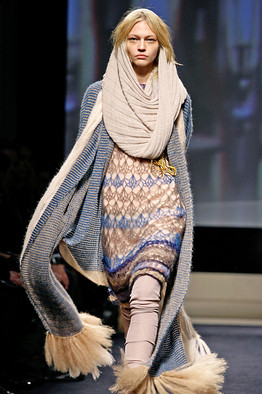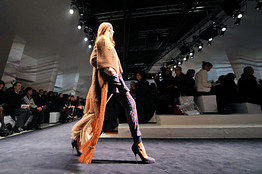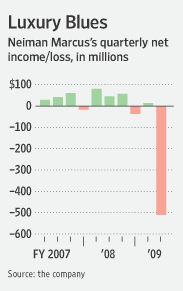Neiman Presses Designers for Cuts
Buyer for Luxury Retailer Prefers Plastic to Crystals; Searching for 'Value' to Sway Full-Price Sales
At the Milan showroom of an Italian fashion designer, Neiman Marcus Group merchant Rachel Goldberger last week watched as a model twirled in a blue silk cocktail dress with origami pleats. "How much is she?" asked Ms. Goldberger, who like many retail executives uses the feminine pronoun to refer to clothes. The response, $4,300, shocked Ms. Goldberger, who did a double take.
Associated Press
Neiman picked this Missoni outfit after praising the designer's cost cuts.
"It's expensive for what it is," she told the designer's sales representative. For the dress to sell, she advised, the price tag should be under $4,000. And to make it more appealing visually, the design house should flatten some folds around the waistline, she added.
Ms. Goldberger's main mission on past trips to Europe was to pick chic and flattering styles that would appear in Neiman Marcus stores six months later. But this season, she is on the front lines of an effort by luxury retailers to push for value. Consumers are now challenging high prices after seeing designer clothes marked down by as much as 75% in recent months.
Coaxing consumers back into the habit of paying full price is a crucial challenge for the luxury goods business. On Wednesday, Dallas-based Neiman posted a $509.2 million fiscal second-quarter loss. It took largecharges to the value of its stores and trade names, reflecting impairments linked to the recession. It was the first holiday-period loss since Neiman began disclosing quarterly results in 1994.
The company said sales for the quarter ended Jan. 31 declined 21% from a year ago, the second consecutive quarterly decline. It earned $44.3 million on sales of $1.37 billion a year ago.
"We have to get the customer to buy [at] full-price," said Ms. Goldberger, Neiman's vice president and divisional merchandise manager for women's designer sportswear. "If you offer the value up front, you won't get this discounting nonsense."
Addressing fears of continued discounting, Neiman Chief Executive Burton Tansky told investors Wednesday, "Full-price selling is what we are concerning ourselves with."
Rachel Goldberger
The six-year boom in luxury goods came to a screeching halt last fall, as wealthy shoppers dramatically cut back on their purchases of designer clothing and other pricey items. Consultant Bain & Co. last month forecast global luxury consumption this year would drop 15% from 2008.
To avoid directly discounting merchandise, Neiman has resorted to some marketing tricks. Last week, for instance, it offered a $500 gift card for those who donated "gently worn" suits to charity. It also sent some regular customers a $50 "perk" card to use toward alterations.
For buyers such as Ms. Goldberger, there is little room for error this year. Retailers have cut their fashion buying plans amid the deepening recession. A Neiman Marcus spokeswoman declined to specify the company's cutbacks, but designers said orders from U.S. retailers are down 20% to 50% from a year ago. Ms. Goldberger and her team of four buyers joked that "down ten is the new flat."
This is a big change for the designers and for Ms. Goldberger, who had grown accustomed to spending more every season. "Nobody wants to walk into a room and say, 'Now we are going to buy less,"' she said.
Ms. Goldberger has also cut expenses, shortening her trip to Milan this year and skipping the Paris shows altogether. She didn't attend any runway shows. Instead, she viewed collections on the Internet and read daily trend reports from Ken Downing, the Neiman's women's fashion director who attended.
She filled days in Milan with showroom visits to see the clothes close up, place orders and push for changes in some designs. Back-to-back meetings ran from 8:30 a.m. until 7:00 p.m., then she headed back to a hotel to meet with the buying team and review orders.
If something costs a lot of money, Mr. Goldberger this season is looking for visible proof it is special and unique. A $7,000 coat with a burnt-out crocodile pattern was worth the money, she said, because of the novelty of the materials. But she dismissed $500 black leggings as "ridiculously overpriced," believing they would probably wind up on the markdown rack.
Getty Images
Buyers in Milan last month viewed Missoni's fall knitwear collection.
In one case, she asked that a hand-painted floral detail on a sweater be eliminated to both lower the price and improve "dry-cleanability," she said. The designer agreed to ship the garment without the paint, which will lower the retail price by 10%.
At the showroom for the knitwear label Missoni, Ms. Goldberger was thrilled to hear that the Swarovski crystals that appeared on a dress on the runway would be replaced with plastic facsimiles. The substitution wouldn't change the look of the garment, but would lower its retail price by more than half, and make it weigh less.
"We are paying attention," said Vittorio Missoni, director of institutional affairs at the family-run label.
Meanwhile, at Blumarine, a brand known for wild prints, the Fall 2009 collection was overflowing with crystal embellishments, pastel leopard-print dresses and gowns in bright colors, like yellow and turquoise. "When everybody else is doing beige, we are a happy collection," said Ricky Riva, the brand's president.
Watching a model parade around in leopard leggings and a matching pony hair coat, Ms. Goldberger suggested that the company do "a fantastic animal story" in its fall advertising campaign.
Ms. Goldberger said she's determined to maintain a "can-do attitude" in the face of adversity. Many designers are stepping up to the challenge of creating more interesting products, she said, and producing smaller, more focused collections.
She is encouraged by trends she saw on the runway, including a "strong shoulder" in suits, jackets and dresses that give women a reason to buy new clothes, she said. Narrow pants are another welcome development, she said, because women will need to buy them to pair with long cardigans.
At the showroom of Brunello Cucinelli, a label known for its expensive cashmere with unusual details, Ms. Goldberger and her team ate lunch while six models struck poses in fur vests, cashmere sweaters, down jackets and riding boots.
Over pasta, Mr. Cucinelli regaled the Neiman team with an impassioned soliloquy, drawing a parallel between the current economic crisis and the end of the Renaissance, when merchants from the west introduced tomatoes, potatoes and maize to Italy.
But Mr. Cucinelli declared that he is not looking back-and doesn't care if he makes a profit this year. "From me, you can expect only a positive attitude," said Mr. Cucinelli, eliciting applause from the assembled crowd, including Ms. Goldberger, Mr. Downing and other Neiman Marcus executives.
"If you continue to give us the quality, the feminine details and the color," said Ms. Goldberger, "we will sell it."










